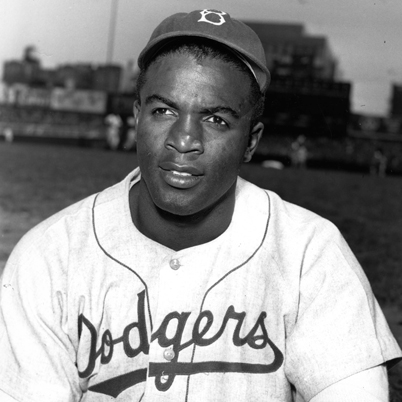Christopher Lamb
Professor of Journalism, University of Indiana-Indianapolis
When Jackie Robinson took the field for the first time in a Brooklyn Dodgers uniform, he shattered baseball’s color barrier. But more than that, he confronted racial discrimination in America, giving millions of blacks hope for equality not only in sports but in jobs, housing and education.
Robinson is the focus of the movie 42: The True Story of an American Legend, starring Chadwick Boseman as Robinson and Harrison Ford as Branch Rickey, the president of the Brooklyn Dodgers who signed the ballplayer.
There is no greater story in sports than Robinson breaking baseball’s color line on April 15, 1947. Yet there was little sense of that history that day in the sports pages of daily newspapers, even in New York City.
The Brooklyn Eagle left Robinson out of its game story. Eagle columnist Tommy Holmes wrote that it was the first time that “an acknowledged Negro” had taken the field in the major leagues. Dick Young of the Daily News didn’t mention Robinson until the last paragraph of his story. “Red” Smith, one of the greatest names in sportswriting, mentioned Robinson for the first time in the 12th paragraph of his column, referring to the ballplayer as “that dark and anxious young man.”
Arthur Daley of the New York Times, who later became the first sportswriter to win a Pulitzer Prize, did not write about how Robinson did in the game. Instead, Daley tried to assure his readers that Robinson was the “right type” of black man — deferential and quiet, one who never questioned his place. “The muscular Negro minds his own business and shrewdly makes no effort to push himself,” Daley said. “He speaks intelligently when spoken to and already has made a strong impression.”
There was little sense of the significance of the game in daily newspapers throughout the country, which paid little attention to issues of racial discrimination — whether in baseball or elsewhere in society.
Baseball could not have maintained the color line as long as it did without the aid and comfort of the country’s white mainstream sportswriters, who participated in what black sportswriter Joe Bostic of the People’s Voice and other black sportswriters called a “conspiracy of silence.”
The story of the campaign to integrate baseball remained unknown to most whites in the United States. To blacks, however, it was one of the most important stories involving racial equality in the 1930s and 1940s. Black sportswriters, including Bostic, Sam Lacy, and Wendell Smith framed the campaign to end segregation in baseball in terms of democracy and equal opportunity. To black newspapers, if there could be racial equality in baseball, there could be racial equality elsewhere in society.
Black sportswriters took their campaign to baseball commissioner Kenesaw Mountain Landis. They made their case to baseball executives at their annual meeting. They met individually with a number of team owners who promised tryouts and then canceled the tryouts. And yet the story of the campaign to desegregate baseball remained unknown to most of the United States.
White baseball fans did not know that blacks were prohibited from the game. They did not know that there were blacks good enough to play in the major leagues. They did not know that many major league managers and players supported integration. They also did not know that sportswriters had their own color line — the baseball writers’ association prohibited blacks.
When sportswriters said anything about the color line, which was not often, they justified the absence of blacks in baseball with blatant dishonesty. J.G. Taylor Spink, the influential editor of the Sporting News, said that integration would cause race riots in the bleachers. He said that there were no blacks good enough for the big leagues. He said that neither black nor white players supported desegregation.
The failure of sportswriters to cover the campaign to integrate baseball reflects a larger failure of the press to cover the campaign to integrate American society in the 1940s and 1950s. This failure ill prepared the United States for the Civil Rights Movement that would shake the foundation of the country in the 1950s and 1960s. The Kerner Commission criticized the news media in its 1968 report. “It is the responsibility of the news media to tell the story of race relations in America,” the commission said, and the news media had failed in their responsibility.
Most sportswriters were conservative in their politics yet evangelical in their belief that baseball represented the American dream because everyone was equal on the playing field. As a result, according to one historian, they “wrote fantasies about the great American pastime … and were generally apathetic about baseball’s color line.”
A relative few sportswriters raised the issue in their columns and articles. “There’s a couple of million dollars worth of baseball talent on the loose ready for the big leagues,” Shirley Povich wrote in the Washington Post in 1939, “yet unsigned by any major leagues. Only one thing is keeping them out of the big leagues — the color of their skin.”
But most sportswriters never mentioned the color line. Some said nothing because they did not run the risk of offending their editors, readers, or advertisers. Others believed that segregation was in the best interests of both baseball and the country.
I once asked Povich why so few white other sportswriters called for the end of the color line. “I’m afraid the sportswriters were like the club owners,” he said, “they thought separate was better.”
Chris Lamb is the author of Conspiracy of Silence: Sportswriters and the Long Campaign to Desegregate Baseball.

